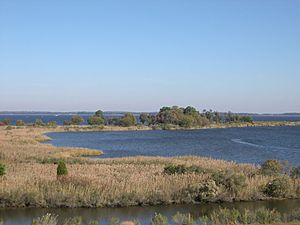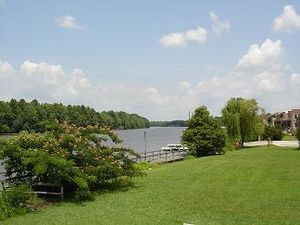Tidewater (region) facts for kids
The Tidewater is a special area along the east coast of the United States. It's known for its low-lying land and how the ocean's tides affect its rivers and bays.
What is the Tidewater Region?
The name "Tidewater" comes from how the ocean's tides reach far inland on rivers and sounds. This makes the water levels go up and down even far from the ocean.
Culturally, the Tidewater region usually means the flat areas of:
- Southeastern Virginia
- Northeastern North Carolina (the Albemarle Region)
- Southern Maryland
- The Chesapeake Bay area
Geographically, the Tidewater region is much larger. It stretches about 50,000 square miles. This area goes from Long Island in New York all the way south to the bottom of North Carolina. It also includes the state of Delaware and the Delmarva Peninsula.
This region has a long history and a unique culture. People here once spoke special kinds of English, though these are slowly fading away.
Exploring the Tidewater's Geography


The Tidewater region formed after the last ice age. As the sea level rose, it flooded river valleys near the coast. These flooded valleys are now where the tides can reach far inland. In some places, the tides affect water levels all the way to the Fall Line. The Fall Line is a natural border where the land starts to rise, and you might see waterfalls or rapids.
The land in the Tidewater is generally flat and low. Many areas near the coast are made of tidal marsh (grassy wetlands) and swamp (forested wetlands). A lot of the region is covered with a type of wetland called pocosin. Higher areas are often used for farming.
In North Carolina and Virginia, the Tidewater is the land between the Suffolk Scarp and the Atlantic Ocean. In Maryland, it includes the flooded river areas below the Fall Line. The Hampton Roads area in Virginia is a well-known part of the Tidewater. Southern Maryland, the Eastern Shore, and parts of Delaware make up the northern section of this region, especially around the Chesapeake and Delaware Bays.
The Tidewater region is home to plants found in the South Atlantic pine forests. It also has special coastal plants, especially in southeastern Virginia.
Tidewater Accents
In the past, people in the coastal Tidewater region of Virginia spoke with a special non-rhotic accent. This means they often didn't pronounce the "r" sound at the end of words, like saying "cah" instead of "car." This "Tidewater accent" was common among upper-class white speakers in the 1800s and early 1900s.
However, on the actual islands within the Chesapeake Bay, a different accent still exists. This accent does pronounce the "r" sound. It's sometimes called "Hoi Toider" by locals.


